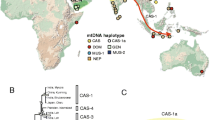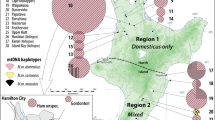Abstract
The distribution of distinct genetic lineages of mice in New Zealand, combined with historical records of shipping routes, political decisions, market prices, trading patterns and immigration policy, suggest that two distinct lineages of Mus musculus travelled separate routes to reach opposite ends of New Zealand in early pre-colonial times (1792–1830). (1) Mus musculus castaneus could have colonised the southern South Island between 1792 and 1810, with sealers returning from the Canton fur market, but these voyages were illegal (=undocumented) because direct trading with China was prohibited until after 1813. Signs that the potential links between the South Island and Canton were seldom used after 1810 include: (a) the Canton sealskin market was already rapidly declining in profitability by the time sealers switched to New Zealand from Bass Strait in 1804; (b) the Otago colonies of fur seals (Arctocephalus forsteri) were exhausted after 1810; (c) M. m. castaneus is absent from the southern offshore islands repeatedly visited by Sydney-based sealers after 1810. (2) M. m. domesticus had multiple well-documented opportunities to colonise the Bay of Islands with traders from Australia after 1821, and both the Cook Strait area and the southern South Island with whalers after 1829. After 1840, multiple haplotypes of M. m. domesticus from different European sources accompanied the organised settlement of New Zealand by European colonists.



Similar content being viewed by others
References
Anon (1863) A journey up country No II: Tuapeka to Millers Flat. Otago Witness, 1 July, p 6
Anon (1864) A gold-digger’s notes on Otago. Otago Daily Times, 11 August, p 6
Baker AIM (1994) Stowaway transport rates of house mice (Mus domesticus) and deermice (Peromyscus maniculatus). In: Halverson WS, Crabb AC (eds) Proceedings of the 16th vertebrate pest conference. Davis, CA, pp 106–112
Begg AC, Begg NC (1966) Dusky Bay. Whitcombe & Tombs, Christchurch
Begg AC, Begg NC (1979) The World of John Boultbee: including an account of sealing in Australia and New Zealand. Whitcoulls, Christchurch
Berry RJ, Scriven PN (2005) The house mouse: a model and motor for evolutionary understanding. Biol J Linn Soc 84:335–347
Blackburn TM, Lockwood JL, Cassey P (2015) The influence of numbers on invasion success. Mol Ecol 24:1942–1953
Bonhomme F, Searle JB (2012) House mouse phylogeography. In: Macholán M, Baird SJE, Munclinger P, Pialek J (eds) Evolution of the house mouse. Cambridge University Press, Cambridge, pp 278–296
Boursot P, Auffray J-C, Britton-Davidson J et al (1993) The evolution of house mice. Annu Rev Ecol Syst 24:119–152
Bradshaw J (2009) Golden prospects: Chinese on the West Coast of New Zealand. West Coast Historical and Mechanical Society Inc., Greymouth
Bridgman LJ, Innes J, Gillies C et al (2013) Do ship rats display predatory behaviour towards house mice? Anim Behav 86:257–268
Church IN (2002) Opening the manifest on Otago’s infant years: shipping arrivals and departures, Otago Harbour and coast 1770–1860. Otago Heritage Books, Dunedin
Cleland JB (1918) Presidential address. J Proc R Soc N S W 52:1–166
Cumpston JS (1977) Shipping arrivals and departures Sydney, 1788–1825. Roebuck Society Publication, Canberra
Delibes R, Delibes-Mateos M (2015) Linking historical ecology and invasion biology: some lessons from European rabbit introductions into the New World before the nineteenth century. Biol Invasions. doi:10.1007/s10530-015-0905-4
Dunlap TR (1999) Nature and the English diaspora: environment and history in the United States, Canada. Cambridge University Press, Cambridge
Förster DW, Gündüz I, Nunes AC et al (2009) Molecular insights into the colonization and chromosomal diversification of Madeiran house mice. Mol Ecol 18:4477–4494
Fowler RM (1980) The Furneaux Group, Bass Strait: a history. Roebuck Society, Canberra
Fraser CI, Banks SC, Waters JM (2015) Priority effects can lead to underestimation of dispersal and invasion potential. Biol Invasions 17:1–8
Gabriel SI, Johannesdottir F, Jones EP et al (2010) Colonisation, mouse-style. BMC Biol 8:131–134
Gabriel SI, Stevens MI, da Luz Mathias M et al (2011) Of mice and ‘Convicts’: origin of the Australian house mouse, Mus musculus. PLoS ONE 6:1–6
Gibson JR (1992) Otter skins, Boston ships, and China goods: the maritime fur trade of the Northwest Coast, 1785–1841. University of Washington Press, Seattle
Gillies R (1878) Notes on some changes in the fauna of Otago. Trans N Z Inst 10:306–322
Glasson HA (1957) The Golden Cobweb: a saga of the Otago Goldfields, 1861–64. Otago Daily Times, Dunedin
Guthrie-Smith H (1969) Tutira. The story of a New Zealand sheep station 4e [1e 1921]. A. H. & A. W. Reed, Wellington
Hainsworth DR (1972) The Sydney traders: Simeon Lord and his contemporaries. Cassell Australia, Melbourne
Hall-Jones FG (1945) Historical Southland. Southland Historical Committee, Invercargill
Jameson RG (1842) New Zealand, South Australia and New South Wales: a record of recent travel in these colonies, with especial reference to emigration and the advantageous employment of labour and capital. Smith, Elder & Co, London
Jing M, Hon-Tsen Y, Bi X et al (2014) Phylogeography of Chinese house mice (Mus musculus musculus/castaneus): distribution, routes of colonization and geographic regions of hybridization. Mol Ecol 23:4387–4405
Jones EP, Searle JB (2015) Differing Y chromosome versus mitochondrial DNA ancestry, phylogeography, and introgression in the house mouse. Biol J Linn Soc 115:348–361. doi:10.1111/bij.12522
Jones EP, Jóhannesdóttir F, Gündüz I et al (2011) The expansion of the house mouse into north-western Europe. J Zool 283:257–268
Jones EP, Eager HM, Gabriel SI et al (2013) Genetic tracking of mice and other bioproxies to infer human history. Trends Genet 29:298–308. doi:10.1016/j.tig.2012.11.011
King CM (1982) Age structure and reproduction in feral New Zealand populations of the house mouse (Mus musculus), in relation to seedfall of southern beech. N Z J Zool 9:467–479 (with correction in vol 10)
King M (2003) The penguin history of New Zealand. Penguin Books, Auckland
King CM (ed) (2005) The handbook of New Zealand mammals, 2e. Oxford University Press, Melbourne
King CM, Alexander A, Cursons R et al (2016) What can the geographic distribution of mtDNA haplotypes tell us about the invasion of New Zealand by house mice Mus musculus? Biol Invasions. doi:10.1007/s10530-016-1100-y
Ling JK (1999) Exploitation of fur seals and sea lions from Australian, New Zealand and adjacent subantarctic islands during the eighteenth, nineteenth and twentieth centuries. Aust Zool 31:323–350
MacKay JWB, Alexander A, Hauber ME et al (2013) Does genetic variation among invasive house mice in New Zealand affect eradication success? N Z J Ecol 37:18–25
McCormick HM, Cursons R, Wilkins RJ et al (2014) Location of a contact zone between Mus musculus domesticus and M. m. domesticus with M. m. castaneus mtDNA in southern New Zealand. Mamm Biol 79:297–305. doi:10.1016/j.mambio.2014.05.006
McNab R (ed) (1908) Historical records of New Zealand, vol 1. Government Printer, Wellington
McNab R (1909) Murihiku (3e): a history of the South Island of New Zealand and the islands adjacent and lying to the south, from 1642 to 1835 Whitcombe & Tombs Ltd 1909, reprinted by Cambridge University Press 2011, Wellington
Nathan HW, Clout MN, MacKay JWB et al (2015) Experimental island invasion of house mice. Popul Ecol 57:363–371
Nelson JG (1961) Pre-European trade between Australia, Indonesia, and the Asiatic mainland. Can Geogr 5:18–22
Prickett N (2002) The archaeology of New Zealand shore whaling. Department of Conservation, National Historic Heritage Workshop, Wellington
Richards R (1995) Murihuku re-viewed: a revised history of Southern New Zealand from 1804 to 1844. Lithographic Services, Wellington
Richards R (2003) New market evidence on the depletion of southern fur seals: 1788–1833. N Z J Zool 30:1–9
Richards R (2010) Sealing in the Southern Oceans, 1788–1833. Paremata Press, Wellington
Richards R, Chisholm J (1992) Bay of Islands shipping arrivals and departures 1803–1840. Paremata Press, Wellington
Robins JH, Miller SD, Russell JC et al (2016) Where did the rats of Big South Cape come from? N Z J Ecol 40:229–234
Rochfort J (1853) The adventures of a surveyor in New Zealand. David Bogue, London
Ross JOC (1987) William Stewart: sealing captain, trader and speculator. Roebuck Society, Canberra
Russell JC (2012) Spatio-temporal patterns of introduced mice and invertebrates on Antipodes Island. Polar Biol 35:1187–1195. doi:10.1007/s00300-012-1165-8
Russell JC, Clout MN (2004) Modelling the distribution and interaction of introduced rodents on New Zealand offshore islands. Glob Ecol Biogeogr 13:497–507
Russell JC, Towns DR, Clout MN (2008) Review of rat invasion biology: Implications for island biosecurity. Sci Conserv 286:1–53
Salmon JHM (1963) A history of goldmining in New Zealand. Government Printer, Wellington
Salmond A (1997) Between worlds: early exchanges between Maori and Europeans 1773–1815. Viking, Auckland
Searle JB, Jamieson PM, Gunduz I et al (2009a) The diverse origins of New Zealand house mice. Proc R Soc B 276:209–217
Searle JB, Jones CS, Gűndűz I et al (2009b) Of mice and (Viking?) men: phylogeography of British and Irish house mice. Proc R Soc B 276:201–207
Smith IWG (2002) The New Zealand sealing industry. Dept. of Conservation, Wellington
Taylor R (1855) Te ika a Maui, or, New Zealand and its inhabitants. Wertheim and MacIntosh, London
Taylor RH (1978) Distribution and interaction of rodent species in New Zealand. In: Dingwall PR, Atkinson IAE and Hay C (eds) Ecology and control of rodents in New Zealand nature reserves. NZ Department of Lands and Survey Information Series 4, Wellington, pp 135–141
White T (1890) On rats and mice. Trans Proc N Z Inst 23:194–201
Wilmshurst JM, Anderson AJ, Higham TFG et al (2008) Dating the late prehistoric dispersal of Polynesians to New Zealand using the commensal Pacific rat. Proc Nat Acad Sci USA 105:7676–7680. doi:10.1073/pnas.0801507105
Worthy TH, Holdaway RN (2002) The lost world of the moa. Indiana University Press, Bloomington
Acknowledgments
This project was completed without special funding, as part of my research commitment to the School of Science, University of Waikato. I gratefully acknowledge permission to quote from the genetic data provided by my colleagues A. Alexander, T. L. A. Chubb, R. Cursons, J. W. B. MacKay, H. M. McCormick, E. C. Murphy, A. Veale, and H. Zhang, fully described in King et al. (2016). For indispensable literature resources I thank the University Library and Science Librarian Cheryl Ward, and the many well-stocked second-hand bookshops in the Hamilton area. The MS was much improved by the detailed and helpful comments of Rhys Richards, Alana Alexander, the Associate Editor and two referees.
Author information
Authors and Affiliations
Corresponding author
Rights and permissions
About this article
Cite this article
King, C.M. How genetics, history and geography limit potential explanations of invasions by house mice Mus musculus in New Zealand. Biol Invasions 18, 1533–1550 (2016). https://doi.org/10.1007/s10530-016-1099-0
Received:
Accepted:
Published:
Issue Date:
DOI: https://doi.org/10.1007/s10530-016-1099-0




